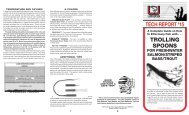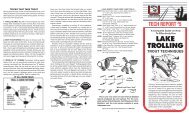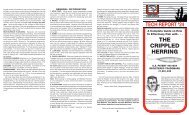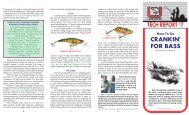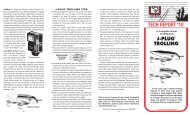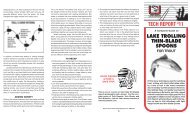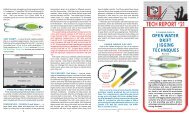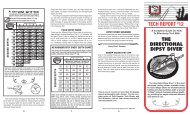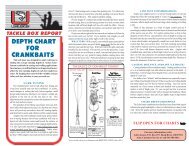HOT SHOTS - Let's Catch Fish
HOT SHOTS - Let's Catch Fish
HOT SHOTS - Let's Catch Fish
Create successful ePaper yourself
Turn your PDF publications into a flip-book with our unique Google optimized e-Paper software.
There are seven popular Hot Shot sizes for rivers:<br />
NO. SIZE WT MAX DEPTH SPECIES<br />
70 1-1/2" 1/10 oz. 3' - 5' trout<br />
60 1-7/8" 1/8 oz. 4' - 6' trout/bass<br />
50 2-1/4" 1/8 oz. 5' - 8' trout/bass<br />
30 2-5/8" 1/4 oz. 10' lg trout/stlhd/slmn<br />
35 2-11/16" 5/16 oz. 12' lg trout/stlhd/slmn<br />
25 3-1/4" 2/3 oz. 18' lg trout/stlhd/slmn<br />
SE 3-1/8" 1/4 oz. 12' lg trout/stlhd/slmn<br />
SE 4-1/4" 3/4 oz. 18' lg stlhd/salmon<br />
Smaller models usually are selected when rivers are<br />
low and clear with the larger sizes used for off-color or<br />
high water. The No. 25 and No. 35 models are extradeep-diving,<br />
high-action plugs especially suited for big<br />
water or deep runs.<br />
Of the many dozens of color finishes available for<br />
river fishing and backtrolling, the following are the most<br />
popular ones that we regularly recommend. As with all<br />
lure colors, individual anglers seem to discover which<br />
ones produce best for them. We encourage you to try<br />
different colors and sizes in your local waters to find<br />
your own favorites.<br />
FOR TROUT<br />
The Hot Shotting technique works equally well for<br />
trout in rivers. The most effective trout finishes are<br />
#0806 Rainbow Trout, #0903 Frog, #0908 Perch, #0912<br />
Black Scale, #0913 Fluorescent Red, #0920 Silver and<br />
#0921 Gold.<br />
Luhr-Jensen’s revolutionary Hot Shot Side Planer<br />
allows any shore-bound angler the ability to reach the<br />
same productive water as the boater. After attaching the<br />
Side Planer to your line, it is placed in the current where<br />
it will skate off across the surface and out into the river<br />
carrying with it a trailing Hot Shot plug. By maneuvering<br />
the Side Planer into position, either by letting out line or<br />
by moving down the bank, the angler can fish a Hot Shot<br />
down through productive water as far as 100 feet away.<br />
Once the Side Planer and lure are in a fishy drift, the<br />
bank angler can, by slowly walking downriver, go "Hot<br />
Shotting" just like a boater. For complete instruction on<br />
the use of the Hot Shot Side Planer, see Tech Report<br />
#2, "How To <strong>Fish</strong> a Hot Shot Side Planer In Rivers” at<br />
your local tackle shop or www.luhrjensen.com.<br />
comes to chinook salmon. Position yourself upstream of<br />
the water you wish to cover (such as a tailout) and then<br />
cast across and slightly downstream. When the plug hits<br />
the water, take several turns on the reel handle to start<br />
it diving. Then simply allow the force of the current to<br />
maintain the dive as the plug swings back across the<br />
river toward you. When the Hot Shot S.E. reaches a<br />
position close to the bank directly downstream of you,<br />
reel in slowly and make another cast.<br />
KWIKFISH ®<br />
Hot Shotting techniques are also incredibly productive<br />
with Luhr-Jensen Kwikfish. "X-Series" Kwikfish such as<br />
the K11X and K13X are designed to dive without additional<br />
weight and are ideally suited for river backtrolling.<br />
Their pronounced swimming actions cause extremely<br />
aggressive responses from fish.<br />
TECH REPORT # 3<br />
A Complete Guide on How<br />
To Effectively <strong>Fish</strong> With<br />
<strong>HOT</strong><br />
S<strong>HOT</strong>S<br />
IN RIVERS<br />
®<br />
The No. 35 Hot Shot is an angler’s dream. This<br />
extra-deep-diving, high-action version of the popular<br />
No. 30 is deadly for all game fish. It’s available with<br />
a rattle.<br />
FOR STEELHEAD AND SALMON<br />
In our plated/metallic finish series try the #0922 Gold/<br />
Green Pirate , #0923 Silver/Blue Pirate, #0935 Metallic<br />
Dark Green, #0943 "Red Magic" (Metallic Red) or #0949<br />
Silver/Blue Top. Of the painted series the #0907 "Cop<br />
Car" (White/Black Head) is an excellent choice.<br />
"Hot Tail " finishes are particularly effective because<br />
they focus strikes on the lure's tail end where exposed<br />
hooks ensure more and better hookups. These are:<br />
#0747 "Grinch" (Silver/Green/Chartreuse Hot Tail),<br />
#0850 "Slammer" (Silver/Chartreuse Tiger & Tail), #0851<br />
"Bubba" (Silver/Fire Red Tiger/Fire Red Tail) and #0856<br />
"Gold Digger" (Gold/Fire Red Tiger & Tail).<br />
6<br />
#35 Hot Shot ® This is one of a series of more than 25 detailed<br />
TO LURE<br />
TO ROD<br />
Hot Shot ® Side Planer<br />
Another way to fish Hot Shots effectively from shore<br />
is to wade out, positioning yourself above fish-holding<br />
water and then work slowly down through it by stripping<br />
out a few feet of line, stopping for a few seconds,<br />
stripping out, stopping and so on.<br />
Yet another effective technique from the bank is the<br />
cast, swing and retrieve method. The Hot Shot ® S.E.<br />
(Special Edition) was designed with casting in mind for<br />
both the bank and boat angler. The 1/2-oz is perfect for<br />
steelhead while the 3/4-oz. size is the choice when it<br />
7<br />
GOOD FISHING<br />
& HAVE A<br />
SAFE TRIP!<br />
reports produced by Luhr-Jensen. For the complete<br />
series of Tech Reports, Tech Sheets and<br />
Tech Bulletins, visit the Luhr-Jensen website at<br />
www.luhrjensen.com.<br />
Visit us on the web at www.luhrjensen.com #8822-005<br />
8<br />
The deadliest boating technique ever<br />
developed for catching game fish in rivers<br />
is "Hot Shotting", one that derived its name<br />
from the Hot Shot ® diving plug. For years,<br />
Hot Shots and Hot Shotting were closelyguarded<br />
secrets of professional river guides.<br />
They had to have successful customers in<br />
order to stay in business. In many areas,<br />
guides attribute 70 percent or more of their<br />
catch to this technique and lure.<br />
This Luhr-Jensen Tech Report will provide<br />
you with many of those closely-guarded<br />
secrets and, we hope, help you enjoy the<br />
same success as the pros.<br />
© Luhr-Jensen of Hood River, Oregon<br />
03 Tech Report Hot Shots.indd 1 1/21/09 11:01:36 AM
The Hot Shot is a self-planing, diving lure. Its design<br />
incorporates a built-in planing bill which makes it dive<br />
when pulled through the water . . . the faster it’s pulled,<br />
the deeper it dives. Because of this built-in, natural swimming<br />
action, Hot Shots are often used with no additional<br />
weight attached to the line. You simply use the existing<br />
river current or reel in line to make the plug dive.<br />
The big advantage of using a non-weighted plug is that<br />
the lure will naturally follow the river currents, guiding it<br />
around snags and rocks, while still maintaining a position<br />
near the bottom, the home of most game fish.<br />
When rigging to use Hot Shots, most any rod and<br />
reel combination is acceptable. The choice will depend<br />
on your personal preference. However, the Hot Shotting<br />
technique has resulted in some very specialized<br />
rods being manufactured for salmon and steelhead,<br />
and "Hot Shot" actions are commonplace. These rods<br />
feature a heavy butt, with a light, sensitive tip that allows<br />
maximum visual contact of the lure’s action. As<br />
you become more familiar with the technique, you may<br />
wish to purchase one of these specialized rods.<br />
Line choices are important in relation to how deep<br />
you wish the plug to dive. Light monofilament lines<br />
generate less water resistance and allow the Hot Shot<br />
to dive deeper, while heavier lines will increase friction<br />
and produce a shallower dive. Braided "superlines" offer<br />
an outstanding combination of incredible strength and<br />
small diameter that provides maximum power, without<br />
sacrificing dive depth. Unique in design, Rapala ®<br />
Titanium ® Stretch Braid offers both those advantages<br />
along with 7% stretch to cushion hard strikes. Choose<br />
20- to 30-pound braid (8- to 10-pound diameter) for<br />
trout and 50- to 65-pound (14- to 20-pound diameter)<br />
for steelhead and salmon. When fishing braids, it's common<br />
to add a barrel swivel and three-foot monofilament<br />
leader between the mainline and lure.<br />
TIP: In order to maintain proper lure action, your<br />
leader should be tied directly to the round Duo-Lock<br />
Snap. Tying a line to the lure eyelet, or using any other<br />
type of snap or snap swivel may adversely affect a Hot<br />
Shot’s built-in action.<br />
The Duo-Lock Snaps provided with each plug are<br />
carefully manufactured to ensure that only a perfectlyrounded,<br />
lightweight wire touches the screw eye on<br />
the lure. This creates optimum swimming action and<br />
maximum fish appeal.<br />
The No. 25 Hot Shot has become a favorite for big<br />
water or where a deep-diving plug is needed. This<br />
extra-deep diving, high-action plug will dive to 18<br />
feet and has a 30-lb. 5-oz steelhead to its credit! An<br />
outstanding plug in heavy flows.<br />
Another of the easiest, yet most important, things you<br />
can do to improve your fishing success, is to maintain<br />
super-sharp hooks at all times. Fine-toothed files such<br />
as those offered by Luhr-Jensen are the absolute best<br />
hook sharpening tools available. Hold it parallel to the<br />
hook point and with gentle, one-way strokes, remove a<br />
small amount of metal on at least two sides of the point<br />
to obtain a sticky-sharp point with a knife-like cutting<br />
edge. Keep the file clean and dry and occasionally spray<br />
it with a non-corrosive lubricant such as WD-40 .<br />
Files are available in 4-1/4" or 5-1/2" sizes.<br />
Hot Shot are rigged with high quality, X strong trebles<br />
which will yield maximum hooking power. A large or<br />
particularly active fish may possibly render a hook<br />
unusable. After landing fish, check the hook carefully.<br />
If it is bent or twisted, replace it. We recommend using<br />
a straight point, X strong hook, such as a VMC 9650,<br />
or an even better choice are inline treble hooks, like<br />
the VMC 5580, that actually improve lure balance and<br />
action by distributing the weight of the hook evenly to<br />
each side of the lure. Hook changes are most easily<br />
executed with a split ring tool like the one found on<br />
Rapala Carbide Pro ® pliers.<br />
The final critical step in rigging the plug is to “tune”<br />
it so that it will dive straight and true while producing<br />
#25 Hot Shot ® optimum action and diving to its maximum depth.<br />
Here is the secret to tuning a Hot Shot: Pull the plug<br />
through the water, observing its diving action. If it dives<br />
straight and true, it requires no additional tuning and will<br />
produce the correct fish-catching action and vibrations.<br />
If it runs off to one side, it needs to be hand-tuned to<br />
assure the ideal action and greatest diving capability.<br />
If the lure runs to the left, then, with the bill facing you,<br />
turn the screw eye slightly clockwise. If the lure digs<br />
#50 Hot Shot ®<br />
The No. 50 is a high-action Hot Shot. This small, but<br />
to the right, turn the screw eye slightly counter-clockwise.<br />
Make small adjustments until the Hot Shot dives<br />
deadly plug dives up to 8 feet and is particularly effective<br />
for steelhead and salmon in low and clear water conditions.<br />
The No. 50 is also and exceptional lure for large trout.<br />
absolutely straight down. Feedback from Luhr-Jensen<br />
Pro Staff members indicates that with proper tuning, a<br />
Hot Shot will outfish any other lure of its type.<br />
provides the optimum results as fish can see the lure<br />
coming and anticipate its arrival.<br />
Tuning Screw Eye<br />
The faster your rod tip pulses, the deeper the plug is<br />
diving. Hold your boat back against the current enough<br />
to force the Hot Shot to dive and then thoroughly work<br />
HOW TO FINE TUNE<br />
through each stretch of fishy water before moving on<br />
YOUR <strong>HOT</strong> S<strong>HOT</strong> ®<br />
RUNS LEFT<br />
RUNS RIGHT<br />
downstream.<br />
TURN<br />
TURN<br />
Again, a Duo-Lock snap (no swivel) comes with each<br />
RIGHT<br />
LEFT<br />
Bill<br />
Hot Shot lure to ensure maximum fish-catching action.<br />
The recommended knot for tying your main line to the<br />
snap is shown below.<br />
River fish treat Hot Shots as invaders to their territories<br />
The No. 30 Hot Shot is the all-around river angling<br />
favorite. It dives to 10 feet and is effective in most<br />
water conditions. Its hook is extended rearward to<br />
nab short strikers, is 2 5/8" long and weighs 1/4-oz.<br />
With the plug rigged and properly tuned, you’re now<br />
ready to fish. Head your boat upstream and above the<br />
area you wish to fish. Row or run your motor just fast<br />
enough to hold even with the current. Strip out or freespool<br />
line until the plug is 50 feet downstream of your<br />
boat. (NOTE: When fishing multiple lines, they should<br />
be at an equal distance from the boat). When you stop<br />
playing out line, the current will make the Hot Shot dive.<br />
The stronger the current, the deeper the lure will dive,<br />
so be sure to maintain constant pressure against it.<br />
As you backtroll through an area, allow your boat to<br />
drop slowly downstream, keeping the lure actively working<br />
at all times by maintaining steady pressure against<br />
the current. To keep the plug constantly wiggling and<br />
diving, always run your boat downstream slower than<br />
the river’s natural speed.<br />
Working a Hot Shot downstream into fish-holding<br />
water (such as that just below a riffle, along a deep<br />
side channel or at the head or tail end of a deep hole)<br />
IMPROVED<br />
CLINCH<br />
KNOT<br />
and react to them with savage strikes. A plug fished too<br />
rapidly through a drift seems to be treated as a passing<br />
invader and often is ignored. A slowly-fished plug, on<br />
the other hand, is an “invader to be dealt with” and will<br />
produce far more strikes as the fish will become irritated<br />
beyond control.<br />
Many fish species also will view a slow-moving plug<br />
as an easy meal, whereas a fast-moving one may require<br />
too much effort to catch and thus, is left alone. Because<br />
of the nature of Hot Shots, and the extreme irritation<br />
they generate, strikes are often vicious. Whenever you<br />
get a strike — set the hook HARD!<br />
2 3<br />
4 5<br />
03 Tech Report Hot Shots.indd 2 1/21/09 11:01:36 AM



